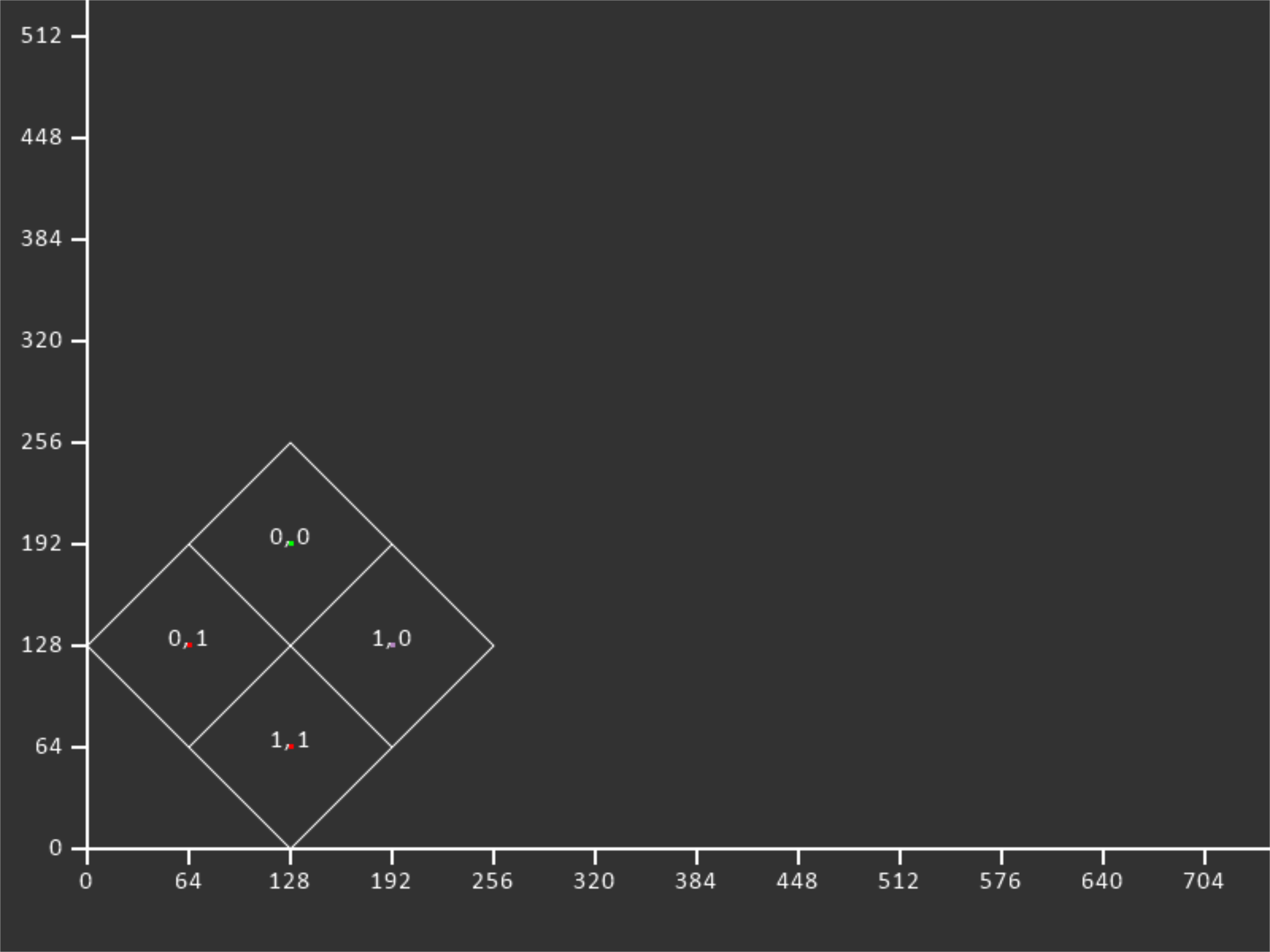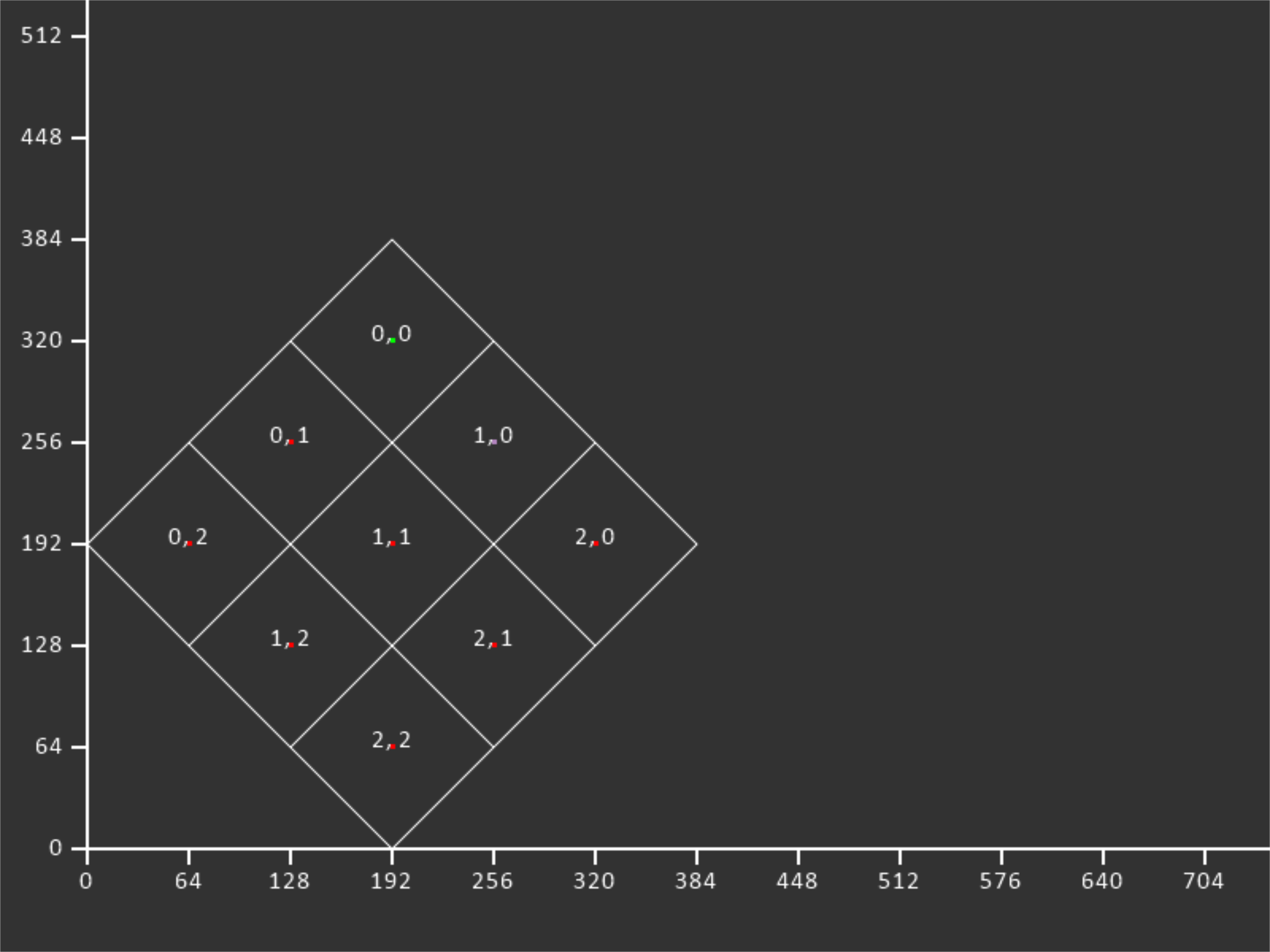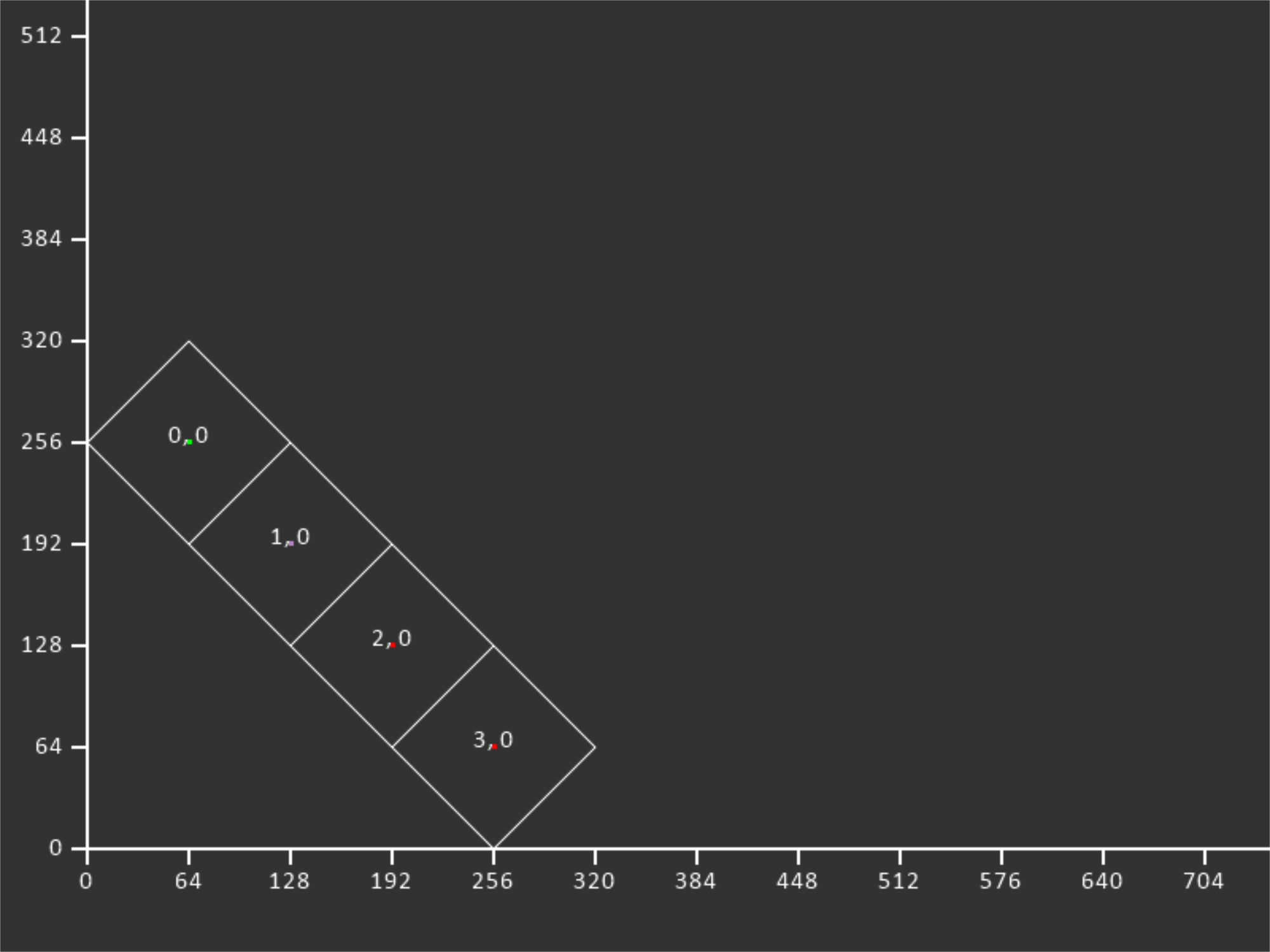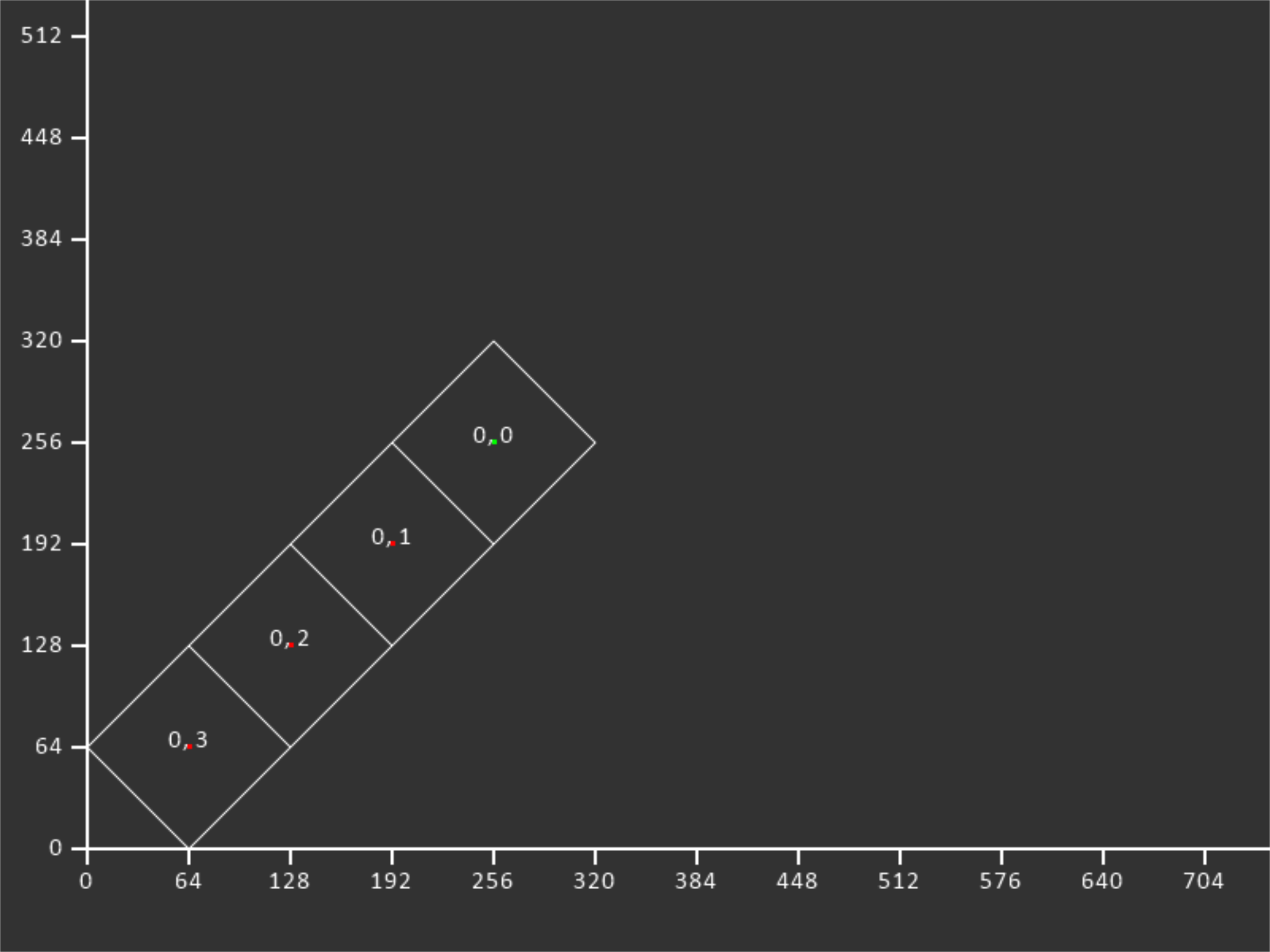Isometric Coordinates¶
Traditional top-down or side-view games normally work in a traditional grid. Graphics are placed in these grid locations. Each graphic is a rectangle, and sometimes they are referred to as “tiles.”
Converting between grid locations and the screen’s pixel coordinates are reasonably straight-forward.
Another type of 2D game uses “Isometric Tiles.” Here, we can fake a 3D view with 2D graphics. We do that by tilting the grid 45 degrees. Each tile then becomes a diamond.
Unfortunately the math to go from pixels to grid locations is no longer straight forward.
Equations For Tiles To Pixels¶
Equations to go from tile coordinates to screen coordinates.
Variable definitions¶
Given:
- tilewidth = width of each tile in pixels
- tileheight = height of each tile in pixels
- tilex = x-coordinate of the tile, in tiles
- tiley = y-coordinate of the tile, in tiles
- width = width of the map, in tiles
- height = hieght of the map, in tiles
Result:
- screenx = x-coordinate of the screen in pixels
- screeny = y-coordinate of the screen in pixels
Equations¶
Equations For Pixels To Tiles¶
Equations to go from screen pixel coordinates to tile coordinates.
This needs to work for any coordinate inside the diamond, not just the center.
Variable definitions¶
Given:
- screenx = x-coordinate of the screen in pixels
- screeny = y-coordinate of the screen in pixels
- tilewidth = width of each tile in pixels
- tileheight = height of each tile in pixels
- width = width of the map, in tiles
- height = hieght of the map, in tiles
Result:
- tilex = x-coordinate of the tile, in tiles
- tiley = y-coordinate of the tile, in tiles
Equations¶
<Insert magic math stuff here.>
Examples¶
2x2 Grid¶

MAP_WIDTH = 2
MAP_HEIGHT = 2
TILE_WIDTH = 128
TILE_HEIGHT = 128
0, 0 => 128, 192
0, 1 => 64, 128
1, 0 => 192, 128
1, 1 => 128, 64
3x3 Grid¶

MAP_WIDTH = 3
MAP_HEIGHT = 3
TILE_WIDTH = 128
TILE_HEIGHT = 128
0, 0 => 192, 320
0, 1 => 128, 256
0, 2 => 64, 192
1, 0 => 256, 256
1, 1 => 192, 192
1, 2 => 128, 128
2, 0 => 320, 192
2, 1 => 256, 128
2, 2 => 192, 64
4x4 Grid¶

MAP_WIDTH = 4
MAP_HEIGHT = 4
TILE_WIDTH = 128
TILE_HEIGHT = 128
0, 0 => 256, 448
0, 1 => 192, 384
0, 2 => 128, 320
0, 3 => 64, 256
1, 0 => 320, 384
1, 1 => 256, 320
1, 2 => 192, 256
1, 3 => 128, 192
2, 0 => 384, 320
2, 1 => 320, 256
2, 2 => 256, 192
2, 3 => 192, 128
3, 0 => 448, 256
3, 1 => 384, 192
3, 2 => 320, 128
3, 3 => 256, 64
4x1 Grid¶

MAP_WIDTH = 4
MAP_HEIGHT = 1
TILE_WIDTH = 128
TILE_HEIGHT = 128
0, 0 => 64, 256
1, 0 => 128, 192
2, 0 => 192, 128
3, 0 => 256, 64
1x4 Grid¶

MAP_WIDTH = 1
MAP_HEIGHT = 4
TILE_WIDTH = 128
TILE_HEIGHT = 128
0, 0 => 256, 256
0, 1 => 192, 192
0, 2 => 128, 128
0, 3 => 64, 64
3x3 Squished Grid¶
The height and width don’t have to equal each other. In fact, they often don’t. Here’s an example where they are different.

MAP_WIDTH = 3
MAP_HEIGHT = 3
TILE_WIDTH = 128
TILE_HEIGHT = 64
0, 0 => 192, 160
0, 1 => 128, 128
0, 2 => 64, 96
1, 0 => 256, 128
1, 1 => 192, 96
1, 2 => 128, 64
2, 0 => 320, 96
2, 1 => 256, 64
2, 2 => 192, 32
Code Example¶
1 2 3 4 5 6 7 8 9 10 11 12 13 14 15 16 17 18 19 20 21 22 23 24 25 26 27 28 29 30 31 32 33 34 35 36 37 38 39 40 41 42 43 44 45 46 47 48 49 50 51 52 53 54 55 56 57 58 59 60 61 62 63 64 65 66 67 68 69 70 71 72 73 74 75 76 77 78 79 80 81 82 83 84 85 86 87 88 89 90 91 92 93 94 95 96 97 98 99 100 101 102 103 104 105 106 107 108 109 110 111 112 113 114 115 116 117 118 119 120 121 122 123 124 125 126 127 128 129 130 131 132 133 134 135 136 137 138 139 140 141 142 143 144 145 146 147 148 149 150 151 152 153 154 155 156 157 158 159 160 161 162 163 164 165 166 167 168 169 170 171 172 173 174 175 176 177 178 179 180 | """
Example code showing Isometric Grid coordinates
"""
import arcade
import os
SCREEN_WIDTH = 700
SCREEN_HEIGHT = 700
MAP_WIDTH = 5
MAP_HEIGHT = 4
TILE_WIDTH = 128
TILE_HEIGHT = 128
def get_screen_coordinates(tile_x, tile_y, width, height, tilewidth, tileheight):
screen_x = tilewidth * tile_x // 2 + height * tilewidth // 2 - tile_y * tilewidth // 2
screen_y = (height - tile_y - 1) * tileheight // 2 + width * tileheight // 2 - tile_x * tileheight // 2
return screen_x, screen_y
class MyGame(arcade.Window):
""" Main application class. """
def __init__(self, width, height):
super().__init__(width, height)
self.axis_shape_list = None
self.isometric_grid_shape_list = None
def setup(self):
""" Set up the game and initialize the variables. """
# Set the background color
arcade.set_background_color((50, 50, 50))
self.axis_shape_list = arcade.ShapeElementList()
# Axis
start_x = 0
start_y = 0
end_x = 0
end_y = SCREEN_HEIGHT
line = arcade.create_line(start_x, start_y, end_x, end_y, arcade.color.WHITE, 2)
self.axis_shape_list.append(line)
# Axis
start_x = 0
start_y = 0
end_x = SCREEN_WIDTH
end_y = 0
line = arcade.create_line(start_x, start_y, end_x, end_y, arcade.color.WHITE, 2)
self.axis_shape_list.append(line)
# x Tic Marks
for x in range(0, SCREEN_WIDTH, 64):
start_y = -10
end_y = 0
line = arcade.create_line(x, start_y, x, end_y, arcade.color.WHITE, 2)
self.axis_shape_list.append(line)
# y Tic Marks
for y in range(0, SCREEN_HEIGHT, 64):
start_x = -10
end_x = 0
line = arcade.create_line(start_x, y, end_x, y, arcade.color.WHITE, 2)
self.axis_shape_list.append(line)
tilewidth = TILE_WIDTH
tileheight = TILE_HEIGHT
width = MAP_WIDTH
height = MAP_HEIGHT
# Gridlines 1
for tile_row in range(-1, height):
tile_x = 0
start_x, start_y = get_screen_coordinates(tile_x, tile_row, width, height, tilewidth, tileheight)
tile_x = width - 1
end_x, end_y = get_screen_coordinates(tile_x, tile_row, width, height, tilewidth, tileheight)
start_x -= tilewidth // 2
end_y -= tileheight // 2
line = arcade.create_line(start_x, start_y, end_x, end_y, arcade.color.WHITE)
self.axis_shape_list.append(line)
# Gridlines 2
for tile_column in range(-1, width):
tile_y = 0
start_x, start_y = get_screen_coordinates(tile_column, tile_y, width, height, tilewidth, tileheight)
tile_y = height - 1
end_x, end_y = get_screen_coordinates(tile_column, tile_y, width, height, tilewidth, tileheight)
start_x += tilewidth // 2
end_y -= tileheight // 2
line = arcade.create_line(start_x, start_y, end_x, end_y, arcade.color.WHITE)
self.axis_shape_list.append(line)
for tile_x in range(width):
for tile_y in range(height):
screen_x, screen_y = get_screen_coordinates(tile_x, tile_y, width, height, tilewidth, tileheight)
point_width = 3
point_height = 3
point = arcade.create_rectangle_filled(screen_x, screen_y, point_width, point_height, arcade.color.LIGHT_CORNFLOWER_BLUE, 3)
self.axis_shape_list.append(point)
print(f"{tile_x}, {tile_y} => {screen_x:3}, {screen_y:3}")
def on_draw(self):
"""
Render the screen.
"""
# This command has to happen before we start drawing
arcade.start_render()
self.axis_shape_list.draw()
# x Labels
for x in range(0, SCREEN_WIDTH, 64):
text_y = -25
arcade.draw_text(f"{x}", x, text_y, arcade.color.WHITE, 12, width=200, align="center",
anchor_x="center")
# y Labels
for y in range(0, SCREEN_HEIGHT, 64):
text_x = -50
arcade.draw_text(f"{y}", text_x, y - 4, arcade.color.WHITE, 12, width=70, align="right",
anchor_x="center")
tilewidth = TILE_WIDTH
tileheight = TILE_HEIGHT
width = MAP_WIDTH
height = MAP_HEIGHT
for tile_x in range(width):
for tile_y in range(height):
screen_x, screen_y = get_screen_coordinates(tile_x, tile_y,
width, height,
tilewidth, tileheight)
arcade.draw_text(f"{tile_x}, {tile_y}",
screen_x, screen_y + 6,
arcade.color.WHITE, 12,
width=200, align="center", anchor_x="center")
def update(self, delta_time):
view_left = -50
view_bottom = -50
arcade.set_viewport(view_left,
SCREEN_WIDTH + view_left,
view_bottom,
SCREEN_HEIGHT + view_bottom)
def on_mouse_press(self, x: float, y: float):
screen_x = x + self.view_left
screen_y = y + self.view_bottom
grid_x = screen_x // TILE_WIDTH
grid_y = screen_y // TILE_HEIGHT
point_x = (screen_x % TILE_WIDTH) - (TILE_WIDTH / 2)
point_y = (screen_y % TILE_HEIGHT) - (TILE_HEIGHT / 2)
# print(f"({screen_x}, {screen_y}) -> ({map_x:.2}, {map_y:.2})")
def main():
""" Main method """
window = MyGame(SCREEN_WIDTH, SCREEN_HEIGHT)
window.setup()
arcade.run()
if __name__ == "__main__":
main()
|